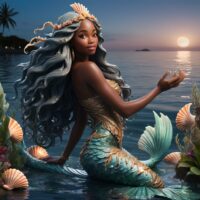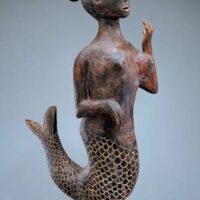Kianda : Goddess of Water
Listen
At a glance
| Description | |
|---|---|
| Origin | Central African Mythology |
| Classification | Gods |
| Family Members | N/A |
| Region | Angola |
| Associated With | Water, Fishermen, Aquatic Life |
Kianda
Introduction
Kianda, also called Dandalunda, holds a central place in the mythology of the Mbundu people of Angola. She is celebrated as the goddess of the sea and the protector of those whose lives depend on the water. Her presence represents both the nurturing and unpredictable nature of rivers, lakes, and oceans. In Luanda, her worship has been preserved for centuries through songs, dances, offerings, and community celebrations, keeping her memory alive despite the passage of time and the influence of foreign religions. Kianda is not only revered as a guardian of water but is also closely linked to fertility, children, and the mysteries of creation itself. Her mythology forms a bridge between people and the natural world, reminding communities of the sacred bond they share with their environment.
Physical Traits
In mythology and oral tradition, Kianda is described as a mermaid-like being with captivating features that distinguish her from humans. She is half woman and half fish, a figure of beauty and mystery. Her long hair, said to flow like seaweed, often symbolizes her connection to the sea, while her skin glimmers like the water’s surface under the sun. Local legends describe her eyes as deep and reflective, holding the vast secrets of the ocean. When she reveals herself, she is often surrounded by radiant light and a whirl of water, a vision of both awe and reverence. Artistic depictions, like those in Angolan paintings and sculptures, highlight her adorned in seashells, pearls, or seaweed, affirming her dominion over aquatic realms. Her physical form serves as a reminder of her duality—at once human and divine, nurturing yet formidable.
Family
The myths surrounding Kianda do not provide detailed accounts of her direct family ties, unlike many other deities in African or global mythologies. Instead, she is often considered part of a collective family of water spirits within Bantu cosmology. This belief holds that every body of water has its own Kianda, meaning her presence is decentralized yet deeply personal to each community. In this way, she embodies both individuality and multiplicity, existing as guardian and spirit of specific rivers, lagoons, and coastal areas. This system of belief reflects the animistic worldview of the Mbundu, where natural elements themselves are imbued with spiritual essence. Though not described with parents, siblings, or children in myth, her role as a spiritual mother to fishermen and families places her at the heart of community life, with her family being the people who honor her.
Other names
Across Angola, Kianda is known by several names, each carrying its own nuance. Dandalunda is among the most common, often used interchangeably with Kianda in rituals and festivals. In Kimbundu traditions, the plural form, Ianda, refers to mermaids collectively, suggesting that Kianda is both one goddess and many. Kituta appears in older folktales and ceremonial contexts as another version of her name. The Mbaka dialect preserves Kiximbi, describing her as a spirit or genius of the waters. These variations emphasize her adaptability across linguistic and cultural regions. Beyond Angola, her identity has crossed borders and even oceans—sometimes compared to Yemanjá in Brazil, a Yoruba-derived water goddess who shares similar attributes. The fluidity of her names underscores her universal significance as a symbol of water, femininity, and protection.
Powers and Abilities
As a goddess tied to the water’s cycles and abundance, Kianda wields immense powers that are both benevolent and fearsome. She is known to govern the seas, lakes, and rivers, controlling the tides and currents. Fishermen invoke her blessings for safety and plentiful catches, often offering food, drink, or clothing to ensure her favor. She is also believed to grant wealth or fertility, with particular associations to the birth of twins—a sign of her nurturing essence. Yet her powers also carry a vengeful side. Legends describe her punishing greed, arrogance, or disrespect by reclaiming treasures she once bestowed or even drawing whole villages into watery depths. Her duality mirrors the ocean itself: calm and life-giving one moment, destructive and unforgiving the next. Beyond her dominion over humans, she is considered a guardian of marine life, an ecological spirit embodying the delicate balance of the natural world.
Modern Day Influence
Kianda continues to play an active role in Angolan cultural identity, far beyond myth and folklore. One of the most visible tributes to her is the annual Luanda Island Feast, where thousands gather to celebrate her through ritual offerings, music, and dance, affirming her as a living goddess in modern times. Angolan literature also preserves her legacy—author Pepetela explores her in works like O Desejo de Kianda and Magias do Mar, using her figure to critique corruption, colonial history, and environmental destruction. These works highlight her as a symbol of resilience, bridging tradition and contemporary social struggles.
In art, Kianda inspires painters, sculptors, and multimedia creators who reinterpret her image for modern audiences. Jorge Gumbe’s “Offerings to Kianda” captures her mystical aura, while blogs and digital media continue to use her symbolism as an emblem of cultural pride. Even science has honored her name—Prognathodon kianda, a mosasaur discovered in Angola, pays tribute to her role as ruler of the sea.
Kianda’s influence also extends into social initiatives and modern spirituality. Organizations such as the Kianda Foundation adopt her name to emphasize fertility, growth, and empowerment, especially in education and women’s rights. Her symbolism has further blended with Christian and regional traditions, creating a syncretic identity where she is at times linked to the Virgin Mary or to other African water goddesses. In this way, Kianda remains a bridge between past and present, myth and modernity, faith and culture.
Related Images
Source
Chatelain, H. (1894). Folk-tales of Angola: Fifty tales, with Ki-mbundu text, literal English translation, introduction, and notes. University of Michigan Library Digital Collections. https://quod.lib.umich.edu/g/genpub/ajs8768.0001.001/300
Onofre, C. (2008, October 28). Angola: On the mermaid Kianda and other mythical beings. Global Voices. https://globalvoices.org/2008/10/28/angola-on-the-mermaid-kianda-and-other-mythical-beings/
Wikipedia contributors. (2023). Kianda. Wikipedia. https://en.wikipedia.org/wiki/Kianda
Unknown. (2011). Kianda – Goddess of the Sea. http://kiandasereia.blogspot.com/2011/12/kianda-goddess-of-sea.html
Frequently Asked Questions
What is lorem Ipsum?
I am text block. Click edit button to change this text. Lorem ipsum dolor sit amet, consectetur adipiscing elit. Ut elit tellus, luctus nec ullamcorper mattis, pulvinar dapibus leo.
What is lorem Ipsum?
I am text block. Click edit button to change this text. Lorem ipsum dolor sit amet, consectetur adipiscing elit. Ut elit tellus, luctus nec ullamcorper mattis, pulvinar dapibus leo.
What is lorem Ipsum?
I am text block. Click edit button to change this text. Lorem ipsum dolor sit amet, consectetur adipiscing elit. Ut elit tellus, luctus nec ullamcorper mattis, pulvinar dapibus leo.
What is lorem Ipsum?
I am text block. Click edit button to change this text. Lorem ipsum dolor sit amet, consectetur adipiscing elit. Ut elit tellus, luctus nec ullamcorper mattis, pulvinar dapibus leo.
What is lorem Ipsum?
I am text block. Click edit button to change this text. Lorem ipsum dolor sit amet, consectetur adipiscing elit. Ut elit tellus, luctus nec ullamcorper mattis, pulvinar dapibus leo.







